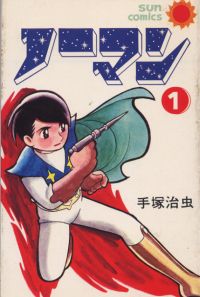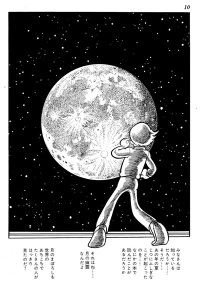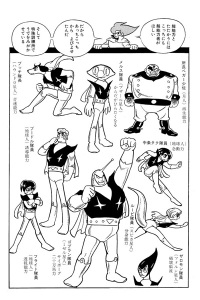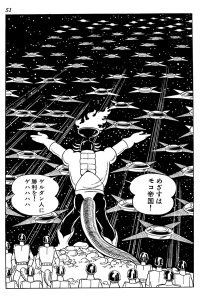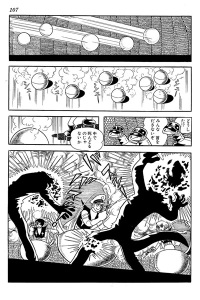Noman (Manga)
Also known as ノーマン (Noruman)
| English Title: | Noman |
| In English? | No |
| Japanese Title: | ノーマン Noman |
| Type: | Ongoing Serial |
| Original run: | 1968/04/28 – 1968/12/22 |
| Published in: | Weekly Shonen King 週刊少年キング |
| Published by: | Shonen Gahosha |
| Volumes: | 3 MT-176 | MT-177 | MT-178 |
Originally published in Weekly Shonen King from April 28, to December 22, 1968, Noman (1968) is another of Osamu Tezuka’s science-fiction team adventure stories depicting humanity’s struggle for survival against an opposing alien enemy – in a similar vein with his earlier works The White Pilot (1961-62) and Number 7 (1961-63).
What it’s about
In the summer of 1968, a mysterious skull-shaped “Phantom Moon” is observed from Earth, marking the start of an epic adventure for young Taku Nakajo. Shortly after the strange appearance of the Moon, Taku’s father receives word from his boss that he’s to report to his new job at the precise coordinates of 1 degree 13 minutes North, 102 degrees 5 minutes East. However, upon arriving at a lonely little cabin in the middle of nowhere, Taku and his family discover they are not the only ones who have been told to report there. What’s more, after encountering Louis Boudre, a Frenchman with the ability to control animals telepathically, and David Flight, an Englishman with x-ray vision and the power to shoot around corners, Taku suddenly manifests his own power of telekinesis.
The group is then led by a mysterious man to Kalukan Fort, which they discover, much to their amazement, is located on the Moon… more than 500 million years in the past!
There they are introduced to Prince Norman, the leader of the Moonlings, who explains to them that they have been recruited from the future to help the humans of the Moon. Despite being at the centre of an interstellar human empire, the Moon is facing an overwhelming attack from a powerful race of alien shape-shifters, known as the Gerudan. As a last-ditch effort to save the Moon from total annihilation, Norman has gathered a team of super-powered humans and aliens to serve as a special fighting force, known as the “Norman Rangers.”
Of course, at first the Earthlings want no part in the conflict. However, when his father is suddenly killed in a Gerudan sneak-attack, Taku vows revenge and begins his training to become a full member of the Norman Rangers. Although the training is harsh – with Taku forbidden by his commanding officer from even seeing his mother, thus severing his only remaining link to home – Taku eventually begins to hone his telekinetic powers to deadly effect. Becoming a full member of the team, Taku forges strong friendships with Loupy, a beautiful young alien girl with the ability to split herself into separate bodies, and Bucci a dog-like alien with the power of super-speed. However, his fellow Earthling, David Flight, craves more than the Norman Rangers can provide, and quickly becomes a double-agent, working for the evil mastermind, Mr. Fumi, and sabotaging Norman’s efforts.
After Loupy is kidnapped and replaced by a shape-shifting Gerudan, things begin to unravel and the Norman Rangers are sent deep into the heart of the Gerudan Empire on a suicide mission. As a massive 120 million strong alien armada slowly descends on the Moon, Taku can’t help but remember that, in the future, the Moon is a desolate wasteland…
What you should know
On one level Noman (1968) treads over very familiar thematic ground for Tezuka, namely the conflict between human and alien races – especially those with the power of transformation. However, unlike earlier works that explored those themes, such as The Adventure of Rock (1952-54) and Zero Men (1959-60), which were largely inspired by Tezuka’s own experiences during World War II, Noman (1968) is more a product of its own time.
The late 1960s in Japan, like many parts of the world, was a time of upheaval. Student movements were especially rife and there was much angst in regards to the on-going conflict in Vietnam. As such, Noman (1968) features some interesting parallels to that conflict. Despite the fantastic nature of telekinetic powers and a trip 500 million years into the past, Taku Nakajo is more or less drafted against his will into a conflict not his own. Also the struggle against the Gerudan aliens, with their cold, lizard-like simplicity and “hive-mind” mentality, parallel the cold-war battle against communism.
With the rise of the gekiga movement in Japanese manga, with its over-the-top portrayals of violence, even manga aimed primarily at children began to take on a more violent edginess, something which was very controversial at the time. Tezuka was disgusted by this trend and, as he makes clear in the Afterword to the Osamu Tezuka Complete Manga Works edition (MT-178), decided to intentionally create a science fiction adventure to counter it.
What is very interesting though, is the direct effect this had on another of Tezuka’s works. As he began to feel the realism in Dororo (1967-69), with is dark depiction of the suffering of the oppressed peasant class during the warring states period, was becoming too violent for a shonen periodical (and with his enthusiasm waning as a result), Tezuka decided to switch gears. And so, somewhat ironically perhaps, the series that is often referred to as his some of his earliest dabbling in the gekiga-like style, was suspended to make room for Noman (1968) in Tezuka’s schedule… eventually condemning Dororo (1967-69) to a rather rushed and unsatisfactory conclusion.

